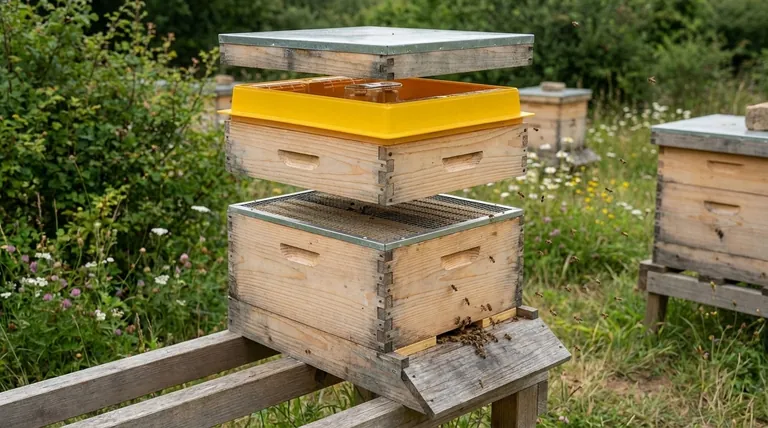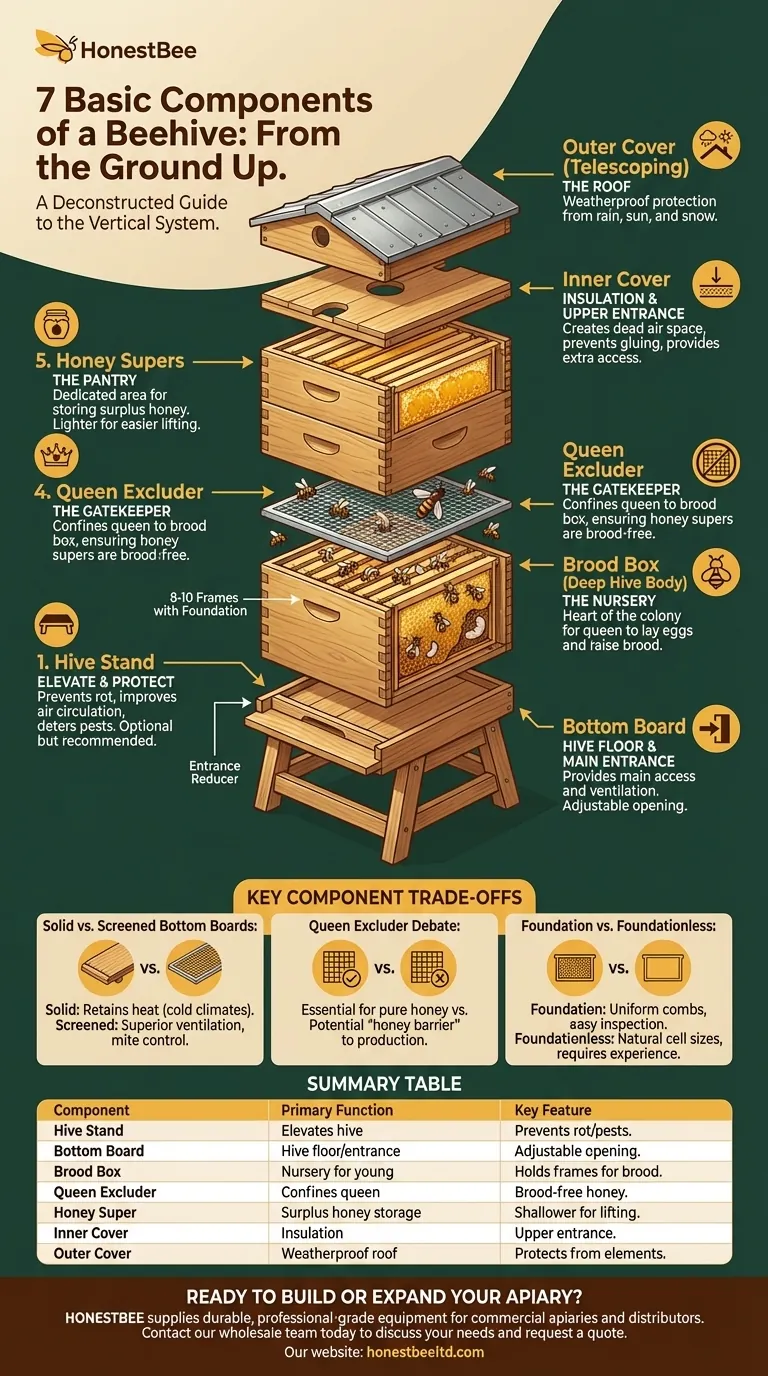From the ground up, a standard beehive is a modular stack of seven key components designed to house a colony and facilitate honey collection. The primary parts are the hive stand, bottom board, a deep hive body (or brood box), a queen excluder, one or more honey supers, an inner cover, and a hive cover. These pieces work together to provide shelter, space for raising young, and dedicated areas for honey storage.
A beehive is not just a box; it's a vertically organized system that mimics a natural tree cavity. Understanding how each component serves a specific function for the bees—from the entrance at the bottom to the weatherproof roof at the top—is the key to successful beekeeping.

Deconstructing the Hive: From Bottom to Top
A modern Langstroth hive is designed to be modular, allowing you to add or remove sections as the colony expands and contracts with the seasons. The components are stacked in a specific order, each playing a critical role in the life of the colony.
The Foundation: Hive Stand & Bottom Board
The hive stand is the optional but highly recommended base. Its purpose is simple: to elevate the hive off the damp ground. This improves air circulation, protects the wood from rot, and makes it harder for pests like ants to enter.
The bottom board serves as the floor of the hive. It provides the main entrance for the bees and, when used with an entrance reducer, allows the beekeeper to adjust the size of the opening. A smaller entrance helps a new or small colony defend itself from predators and robber bees.
The Nursery: The Brood Box
The brood box (also called a deep hive body) is the heart of the colony. This large, deep box is where the queen lives and lays her eggs. It is the primary living quarters and nursery for raising new bees, known as brood.
Inside the brood box hang 8 or 10 frames. Each frame is designed to hold a sheet of foundation (wax or plastic) that encourages the bees to build straight, manageable honeycomb. These frames are where the colony raises its young and stores the pollen and honey needed for its own survival.
The Gatekeeper: The Queen Excluder
The queen excluder is a flat metal or plastic grid placed directly on top of the brood box. The gaps in the grid are large enough for worker bees to pass through easily but too small for the larger queen and drones.
Its function is to confine the queen to the brood box below. This ensures that she only lays eggs in the lower section of the hive, keeping the upper honey storage boxes free of brood.
The Pantry: Honey Supers
Honey supers are the boxes placed above the queen excluder. These are typically shallower than the brood box, making them lighter and easier to lift when full of honey.
Because the queen cannot access this area, the bees use the frames inside the supers exclusively for storing surplus honey. The beekeeper harvests honey from these boxes, which is why they are considered the hive's "pantry." Multiple supers can be stacked on a strong hive during a heavy nectar flow.
The Attic: Inner & Outer Covers
The inner cover sits on top of the uppermost honey super. It creates a dead air space for insulation, provides an extra upper entrance for the bees, and prevents the bees from gluing the outer cover down with propolis (bee glue).
Finally, the outer cover (or telescoping cover) is the hive's roof. It fits over the inner cover and the top of the hive, providing weatherproof protection from rain, sun, and snow.
Understanding Key Component Trade-offs
Choosing the right components involves understanding their functional differences. Certain choices can significantly impact hive health and your beekeeping style.
Solid vs. Screened Bottom Boards
A solid bottom board is traditional and helps retain heat, which can be beneficial in colder climates. A screened bottom board, however, provides superior ventilation, helps control humidity, and is a critical tool for monitoring and managing Varroa mite populations.
The Queen Excluder: A Point of Debate
While essential for ensuring brood-free honey, some beekeepers avoid using queen excluders. They argue it can act as a barrier that slows worker bees down, potentially reducing honey production. This is often called a "honey barrier" and is a common topic of discussion among experienced beekeepers.
Foundation vs. Foundationless Frames
Using frames with pre-made wax or plastic foundation gives the beekeeper control, resulting in straight, uniform combs that are easy to inspect and extract. Going foundationless allows the bees to build their comb with natural cell sizes, a practice preferred by some natural beekeepers, though it can result in more cross-comb and less uniform frames.
Assembling Your First Hive: Core vs. Optional
Your goals will determine the exact configuration you need.
- If your primary focus is a bare-minimum start: You need a bottom board, one deep brood box with frames, an inner cover, and an outer cover to safely house a new colony.
- If your primary focus is a standard beginner setup: Add a hive stand for protection and at least one honey super so you are prepared for the first honey flow.
- If your primary focus is harvesting the purest possible honey: The queen excluder is a non-negotiable component to ensure your honey supers contain only honey, with no eggs or brood.
Ultimately, mastering these components allows you to partner with your bees, providing them with a structure that meets their needs while achieving your beekeeping goals.
Summary Table:
| Component | Primary Function | Key Feature |
|---|---|---|
| Hive Stand | Elevates hive off ground | Prevents rot and deters pests |
| Bottom Board | Hive floor and main entrance | Often used with an entrance reducer |
| Brood Box | Nursery for raising young bees | Holds frames for brood and food stores |
| Queen Excluder | Confines queen to the brood box | Creates a brood-free honey super |
| Honey Super | Storage for surplus honey | Shallower box for easier lifting |
| Inner Cover | Insulation and upper bee entrance | Prevents bees from gluing outer cover down |
| Outer Cover | Weatherproof roof for the hive | Protects colony from rain and sun |
Ready to build or expand your apiary with professional-grade equipment?
HONESTBEE supplies durable, well-designed beekeeping supplies and equipment to commercial apiaries and beekeeping equipment distributors through our wholesale-focused operations. We provide the reliable components you need for healthy, productive hives.
Contact our wholesale team today to discuss your needs and request a quote.
Visual Guide

Related Products
- Professional Hive Top Bee Feeder for Beekeeping
- Telescopic Beehive Outer Cover Lid Roof with Galvanised Sheeting for Langstroth Hive and Beehive Outer Cover
- Professional Galvanized Hive Strap with Secure Locking Buckle for Beekeeping
- Professional Grade Foldable Beehive Handles
- Professional Drop-Style Hive Handles for Beekeeping
People Also Ask
- What is the best bee feeder for a hive? Choose the Right Feeder for Your Apiary's Scale
- What are the advantages of hive top feeders? Maximize Feeding Efficiency for Your Apiary
- What are the features of top feeders for bees? Maximize Hive Health with Safe, High-Capacity Feeding
- What types of hive boxes is the round hive top feeder compatible with? Universal Fit for 8 & 10-Frame Langstroth Hives
- What is a top feeder for bees? Maximize Colony Health with Efficient Feeding



















